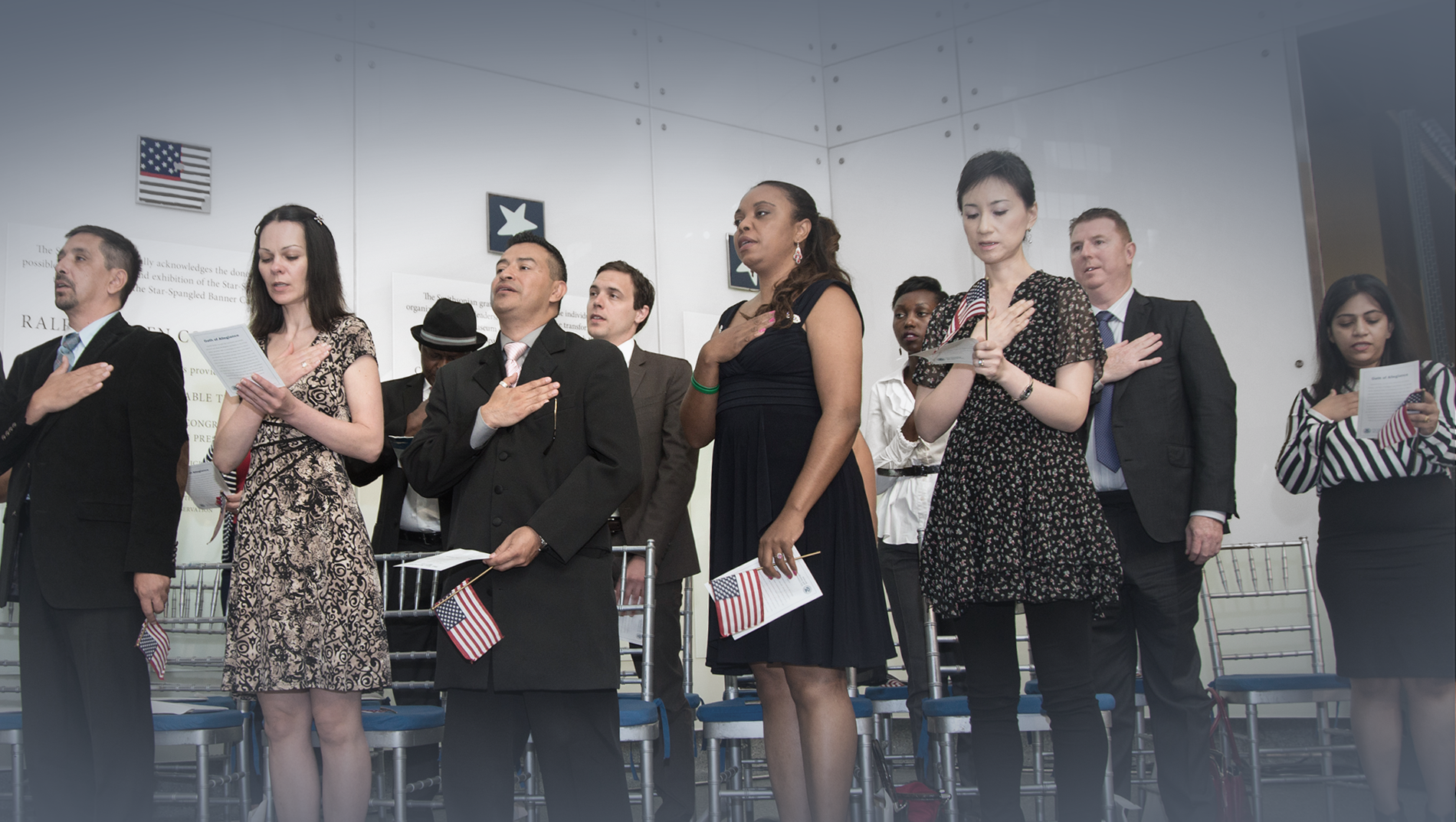Immigration 101
How the United States Immigration System Works
- How the Immigration System Works
- June 24, 2024
U.S. immigration law is very complex, and there is much confusion as to how it works. This fact sheet provides basic information…
Read More
Birthright Citizenship in the United States
- Birthright Citizenship
- October 16, 2024
This fact sheet explains birthright citizenship, the Fourteenth Amendment, and its interpretations. Who is…
Read More
Asylum in the United States
- Asylum
- August 27, 2014
Asylum seekers must navigate a difficult and complex process that can involve multiple government…
Read More
Immigration Tops Economy as Most Important Issue for Latino Voters
According to a poll released yesterday, “U.S. immigration policy” beat out “economy and jobs” as the issue most important for Hispanic voters. The poll, conducted by independent research firm Latino Decisions, asked 500 registered Hispanic voters to name the most important issues facing Hispanics. 51% of respondents said “immigration;” 35% said “economy and jobs;” and 15% said “education.” Pollsters suggest voters’ “direct and personal connection with the problems of the undocumented” as a reason immigration topped the economy—personal relationships that even “affect the political choices of a second or third generation of Latinos born here.” With reform efforts stalled in Congress, many are wondering what kind of political choices Hispanic voters will make in the upcoming 2012 election cycle. Read More

Pending a Resolution of DOMA, Immigration Judges Should Exercise Discretion to Stay Removal Cases
BY BETH WERLIN AND VICTORIA NEILSON To date, five states plus the District of Columbia celebrate marriages of gay and lesbian couples and several other states honor such marriages. In addition, five countries, including Canada, permit marriages of gay and lesbian couples and at least fourteen additional countries recognize same-sex relationships for immigration purposes. Yet, because the U.S. immigration agencies rely on section 3 of the Defense of Marriage Act (DOMA)—defining marriage as a union between one man and one woman—lesbian and gay U.S. citizens and lawful permanent residents are barred from obtaining immigrant visas for their spouses, visas that are available to heterosexual U.S. citizens and residents with foreign-born spouses. Gay and lesbian noncitizens also are precluded from obtaining other immigration protections, including relief from removal, based on a marriage to a U.S. citizen or permanent resident. As a result, families are separated and spouses of U.S. citizens and lawful permanent residents are deported from the United States. Read More

Pending a Resolution of DOMA, Immigration Judges Should Exercise Discretion to Stay Removal Cases
BY BETH WERLIN AND VICTORIA NEILSON To date, five states plus the District of Columbia celebrate marriages of gay and lesbian couples and several other states honor such marriages. In addition, five countries, including Canada, permit marriages of gay and lesbian couples and at least fourteen additional countries recognize same-sex relationships for immigration purposes. Yet, because the U.S. immigration agencies rely on section 3 of the Defense of Marriage Act (DOMA)—defining marriage as a union between one man and one woman—lesbian and gay U.S. citizens and lawful permanent residents are barred from obtaining immigrant visas for their spouses, visas that are available to heterosexual U.S. citizens and residents with foreign-born spouses. Gay and lesbian noncitizens also are precluded from obtaining other immigration protections, including relief from removal, based on a marriage to a U.S. citizen or permanent resident. As a result, families are separated and spouses of U.S. citizens and lawful permanent residents are deported from the United States. Read More

More Immigrants are Educated, Skilled Than Ever Before, Report Finds
A new report released by the Brookings Institution dispels the myth that all immigrants are unskilled, uneducated, and illegal. The report, entitled The Geography of Immigrant Skills: Educational Profiles of Metropolitan Areas, finds that the share of working-age immigrants in the United States who have at least a bachelor’s degree is greater than the share who lack a high-school diploma. Moreover, immigrants with college degrees outnumber immigrants without high-school diplomas by wide margins in more than two-fifths of the nation’s 100 largest metropolitan areas. Read More

Filed Under “M” for “Myth Busted”: Unauthorized Immigrants Pay Taxes, Too
Sadly, myth and misinformation continue to be a major part of the immigration debate. One of the biggest myths perpetuated by restrictionist groups is that the roughly 12 million unauthorized immigrants currently living in the U.S. use a variety of public services yet paying nothing in taxes. Hard data recently released by the Institute for Taxation and Economic Policy (ITEP) however, backs up what economists have been saying for years—undocumented immigrants do, in fact, pay taxes. A new report released yesterday by the Immigration Policy Center (IPC) uses ITEP data to show that unauthorized immigrant households paid a whopping $11.2 billion in state and local taxes in 2010 alone. Read More

Restrictionist Group Blames the Children of Immigrants for America’s Budget Woes
The Center for Immigration Studies (CIS) released another report today attempting to blame our economic woes and budget shortfalls on immigrants—this time using the children of immigrants, most of whom are U.S. citizens, as scapegoats for benefits usage (here Medicaid, food assistance, cash assistance, and housing programs). As are most restrictionists’ attempts to blame immigrants for all of America’s problems, the report is rife with methodological problems. Despite the headline that 57 percent of households headed by an immigrant with children used at least one benefits program, compared to 39 percent for native households, the results actually show that when controlled for income, immigrant households use benefits at the same rate as native born households. Read More

New Census Data Suggest Nativists May Be Headed for Extinction
Newly released data from the 2010 Census reveal the rapid growth of something that is anathema to the nativist agenda: ethnic diversity. The data, analyzed in reports from the U.S. Census Bureau and the Pew Hispanic Center, show that the numbers of Hispanics and Asians in the United States are rising fast. This does not bode well for the anti-immigrant ideology of nativist politicians and their followers. Immigrants account for more than one-third of Hispanics and nearly two-thirds of Asians. Plus, more than one-quarter of both Hispanics and Asians are the native-born children of immigrants. As Hispanics and Asians come to comprise more and more of the population—and the electorate—nativists will become ever more marginalized. Read More

Report on Birthright Citizenship Low on Facts, High on Fantasy
Sometimes it’s easy to miss the most outlandish and unrealistic statements made in the immigration debate given the level of dialed up rhetoric. A recent report from the Center for Immigration Studies (CIS), however, appears to have been written to test just how far into the realm of fantasy the debate can be taken. In Birthright Citizenship for the Children of Visitors: A National Security Problem in the Making?, author W.D. Reasoner (a pseudonym) makes so many preposterous assumptions and calculations that one wonders whether the author used an alias to avoid embarrassment. Read More
Make a contribution
Make a direct impact on the lives of immigrants.

